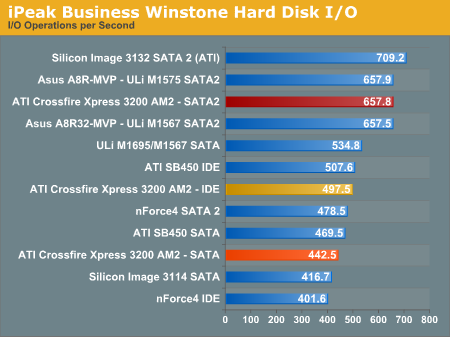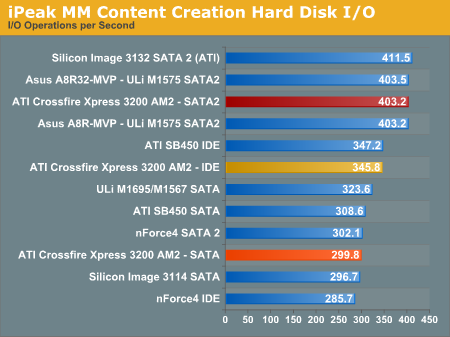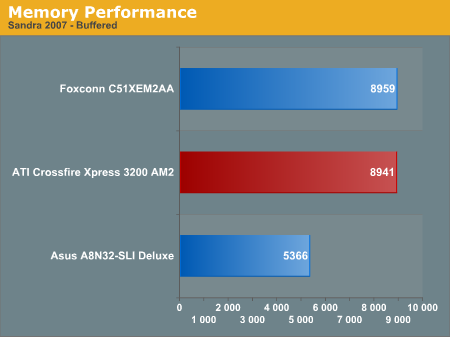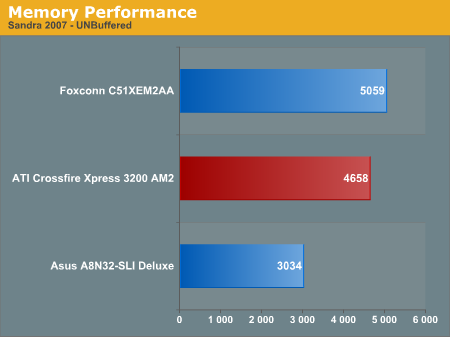CrossFire Xpress 3200: RD580 for AM2
by Wesley Fink on June 1, 2006 12:05 AM EST- Posted in
- Motherboards
Disk Controller Performance
With the variety of disk drive benchmarks available, we needed a means of comparing the true performance of the wide selection of controllers. The logical choice was Anand's storage benchmark first described in Q2 2004 Desktop Hard Drive Comparison: WD Raptor vs. the World. The iPEAK test was designed to measure "pure" hard disk performance. The hard drive is kept as consistent as possible while varying the hard drive controller; The idea is to measure the performance of a hard drive controller with a consistent hard drive.
We played back Anand's raw files that recorded I/O operations when running a real world benchmark - the entire Winstone 2004 suite. Intel's iPEAK utility was then used to play back the trace file of all IO operations that took place during a single run of Business Winstone 2004 and MCC Winstone 2004. To try to isolate performance differences to the controllers that we were testing, we used the Maxtor 120GB 7200 RPM 8MB cache IDE drive in all IDE tests. SATA1 tests used the 60GB 7200RPM 8MB DiamondMax Plus 9, and SATA2 was tested with the Hitachi 250GB SATA2 drive with SATA2 enabled with the Hitachi utility. The drive was formatted before each test run and a composite average of 5 tests on each controller interface was tabulated in order to ensure consistency in the benchmark.
iPEAK gives a mean service time in milliseconds; in other words, the average time that each drive took to fulfill each IO operation. In order to make the data more understandable, we report the scores as an average number of IO operations per second so that higher scores translate into better performance.


Any concerns about SB600 should be put to rest with these tests. IDE, SATA and SATA2 test results are very competitive with NVIDIA, ULi, and Silicon Image. The performance patterns hold steady across both Multimedia Content IO and Business IO, with the ULi, ATI, and Silicon Image based disk controllers providing the fastest IO operations followed by the on-board NVIDIA nForce4 SATA controllers. The performance generated by the ULi and ATI IDE controller logic is particularly excellent, while the SATA performance of both is up to 12% better when compared to the nForce4 chipset. The SATA performance of the Silicon Image 3132 is very competitive with the core logic chipsets in our tests.
Memory Testing - Optimum tRAS
As expected, DDR2 memory behaves quite differently than DDR in tRAS testing. As you can see from the standard chart below, a 2GB kit of Corsair 8500 (DDR2-1066) experienced steadily increasing bandwidth until the maximum tRAS setting of 18 was reached.
This is a very different pattern than DDR tRAS testing, where maximum bandwidth was reached at some intermediate tRAS setting and bandwidth decreased as tRAS was decreased or increased from this optimum value. In fact, at tRAS 18 we did get the highest bandwidth with all else equal, but the tRAS 18 setting was unstable - causing memory failures and random reboots.
We did further memory testing using Sandra 2007 unbuffered test results and found the optimum combination of bandwidth and stability was achieved at a tRAS setting of 13. Similar results were achieved with the DDR2 8500 Corsair memory on the nForce 590 chipset. We have shared our test results with Corsair and asked for more information on tRAS settings, performance, and stability with high-speed DDR2 memory. All stock benchmarking was performed with Corsair 8500 settings of DDR2-800 at 3-3-3-13 settings at 2.147V.
Memory Bandwidth
Memory bandwidth performance was verified using Sandra 2007. Both buffered and unbuffered tests were run with the stock 4800+ at DDR2-800 3-3-3-13 at 2.147V.


Both standard Buffered Sandra 2007 Memory Performance and Unbuffered Performance are almost identical in the ATI RD580 AMD and the NVIDIA 590 chipsets. This clearly demonstrates that both architectures perform about the same using the same memory and the same CPU with on-board AM2 memory controller. Any differences between the ATI and NVIDIA AM2 memory scores are likely the result of memory tweaking.
You can clearly see the AM2 processor exhibits dramatically higher memory bandwidth than the Athlon64 in Socket 939 running DDR memory. Unfortunately, that much improved memory bandwidth does not currently translate into similarly improved performance.
With the variety of disk drive benchmarks available, we needed a means of comparing the true performance of the wide selection of controllers. The logical choice was Anand's storage benchmark first described in Q2 2004 Desktop Hard Drive Comparison: WD Raptor vs. the World. The iPEAK test was designed to measure "pure" hard disk performance. The hard drive is kept as consistent as possible while varying the hard drive controller; The idea is to measure the performance of a hard drive controller with a consistent hard drive.
We played back Anand's raw files that recorded I/O operations when running a real world benchmark - the entire Winstone 2004 suite. Intel's iPEAK utility was then used to play back the trace file of all IO operations that took place during a single run of Business Winstone 2004 and MCC Winstone 2004. To try to isolate performance differences to the controllers that we were testing, we used the Maxtor 120GB 7200 RPM 8MB cache IDE drive in all IDE tests. SATA1 tests used the 60GB 7200RPM 8MB DiamondMax Plus 9, and SATA2 was tested with the Hitachi 250GB SATA2 drive with SATA2 enabled with the Hitachi utility. The drive was formatted before each test run and a composite average of 5 tests on each controller interface was tabulated in order to ensure consistency in the benchmark.
iPEAK gives a mean service time in milliseconds; in other words, the average time that each drive took to fulfill each IO operation. In order to make the data more understandable, we report the scores as an average number of IO operations per second so that higher scores translate into better performance.


Any concerns about SB600 should be put to rest with these tests. IDE, SATA and SATA2 test results are very competitive with NVIDIA, ULi, and Silicon Image. The performance patterns hold steady across both Multimedia Content IO and Business IO, with the ULi, ATI, and Silicon Image based disk controllers providing the fastest IO operations followed by the on-board NVIDIA nForce4 SATA controllers. The performance generated by the ULi and ATI IDE controller logic is particularly excellent, while the SATA performance of both is up to 12% better when compared to the nForce4 chipset. The SATA performance of the Silicon Image 3132 is very competitive with the core logic chipsets in our tests.
Memory Testing - Optimum tRAS
As expected, DDR2 memory behaves quite differently than DDR in tRAS testing. As you can see from the standard chart below, a 2GB kit of Corsair 8500 (DDR2-1066) experienced steadily increasing bandwidth until the maximum tRAS setting of 18 was reached.
| Memtest86 Bandwidth ATI CrossFire Xpress 3200 AM2 with Athlon X2 4800+ |
|
| 6 tRAS | 2047 |
| 7 tRAS | 2047 |
| 8 tRAS | 2047 |
| 9 tRAS | 2047 |
| 10 tRAS | 2047 |
| 11 tRAS | 2140 |
| 12 tRAS | 2140 |
| 13 tRAS | 2191 |
| 14 tRAS | 2191 |
| 15 tRAS | 2242 |
| 16 tRAS | 2242 |
| 17 tRAS | 2298 |
| 18 tRAS | 2298 |
This is a very different pattern than DDR tRAS testing, where maximum bandwidth was reached at some intermediate tRAS setting and bandwidth decreased as tRAS was decreased or increased from this optimum value. In fact, at tRAS 18 we did get the highest bandwidth with all else equal, but the tRAS 18 setting was unstable - causing memory failures and random reboots.
We did further memory testing using Sandra 2007 unbuffered test results and found the optimum combination of bandwidth and stability was achieved at a tRAS setting of 13. Similar results were achieved with the DDR2 8500 Corsair memory on the nForce 590 chipset. We have shared our test results with Corsair and asked for more information on tRAS settings, performance, and stability with high-speed DDR2 memory. All stock benchmarking was performed with Corsair 8500 settings of DDR2-800 at 3-3-3-13 settings at 2.147V.
Memory Bandwidth
Memory bandwidth performance was verified using Sandra 2007. Both buffered and unbuffered tests were run with the stock 4800+ at DDR2-800 3-3-3-13 at 2.147V.


Both standard Buffered Sandra 2007 Memory Performance and Unbuffered Performance are almost identical in the ATI RD580 AMD and the NVIDIA 590 chipsets. This clearly demonstrates that both architectures perform about the same using the same memory and the same CPU with on-board AM2 memory controller. Any differences between the ATI and NVIDIA AM2 memory scores are likely the result of memory tweaking.
You can clearly see the AM2 processor exhibits dramatically higher memory bandwidth than the Athlon64 in Socket 939 running DDR memory. Unfortunately, that much improved memory bandwidth does not currently translate into similarly improved performance.










71 Comments
View All Comments
lopri - Thursday, June 1, 2006 - link
Most of responses below my post didn't read my points. I'll be paitently waiting for AT staff's responses. In the meantime, you guys can check:http://www.anandtech.com/memory/showdoc.aspx?i=267...">http://www.anandtech.com/memory/showdoc.aspx?i=267...
http://www.anandtech.com/memory/showdoc.aspx?i=239...">http://www.anandtech.com/memory/showdoc.aspx?i=239...
And the sub-reviews. If DDR400(2-2-2) are DDR600(2.5-3-3), I guess all those memory reviews on AT were wasting of time?
Ahe here is the DIMM sticks this review used for AM2 platform.
http://www.newegg.com/Product/Product.asp?Item=N82...">http://www.newegg.com/Product/Product.asp?Item=N82...
Oh that's not it. While searching, I found that decent DDR2-800 would cost >$250, and higher speed/same timing or same speed/timing sticks will (if you were to buy) dig a big hole in your packet. (think $500) Is that mainstream? What about the 1T issue??
The top of the line Socket 939 vs Socket AM2 comparison could be something like this:
2 x 512MB: DDR600 with 2.5-3-3-7 (less thanl $150) vs DDR2-800 with 3-3-3 ($500) or,
2 x 1GB: DDR500 with 2.5-3-2-7 (less than $200) vs DDR200-800 with 4-4-4 ($250)
Think about how mwny mobo/memory reviews we've seen here on AT? Why don't we use the knowledge we learned from those founding to compare Socket 939 and Socket AM2?
Spoelie - Thursday, June 1, 2006 - link
You need a reality check. Lots of reviews have pointed out that the higher cost of TCCD memory and such is not worth the little extra performance, except if you're a serious overclocker that just really wants to run his mem on 1:1 and need the frequency headroom.The common setup out there is not 270-2.5/3/2 or whatever, it is 200-2.5/3/3/8 or even CL3. Especially with the higher density memories like 1GB sticks. THAT is what most persons are running. If anything, the 2/2/2 200 are a bit too high end for the majority of people. And they're also reading AT.
lopri - Thursday, June 1, 2006 - link
What you're saying is not totally out of my context. My main meat was towards the reviewers. Does anyone here own a DDR2-800/3-3-3? (Forget about TCCD 270MHz) DO you know how much they are? Indeed, such memory is not even officially out yet. But AT is using those sticks for AM2 system but at the same time for Socket 939 system they use more "pedestrian" DDR400/2-2-2. These days you can by 2 x 1GB DDR400/2-3-2 for under $200.Wesley Fink - Thursday, June 1, 2006 - link
The Corsair 8500 we used for testing is NOT rated at DDR2-800 3-3-3 - it is actually rated at DDR2-1066 5-5-5-15. The fact is it will run at DDR2-800 3-3-3 with voltage in the 2.1 to 2.2v range. So will most other recent dimms based on Micron memory chips. At stock voltage of 1.8v it runs about 4-4-4-13.Where TCCD was capable of DDR400 2-2-2 and DDR500 2.5-2-3 or 2.5-3-3, Micron chips are currently the top-performing chips for DDR2. Infineon also has DDR2 chips that perform at lower latency and they are generally priced more reasonably.
Our memory articles ALWAYS compare performance at different memory speeds, but the fact is DDR400 was the fastest memory standard for DDR. Anything higher was overclocking. For DDR2, we have DDR2-800 as the current highest standard speed, though there will likely be a DDR2-1066 speed in the near future.
When we point out that the massive bandwidth increases in DDR2 on AM2 have almost no impact on performance, surely it is obvious that AM2 is not memory bandwidth starved. We found on DDR that the on-chip memory controller for AMD was very sensitive to latency improvements. In fact hte mad shrimp article unintentionally shows just that - gaming responded more to latency improvement than bandwidth improvement. That will also likely be the case in DDR2 EXCEPT with such a massive increase in bandwidth over DDR, latency may not matter nearly so much. We will take a closer look at htis in a future memory article.
peternelson - Thursday, June 1, 2006 - link
Price of fast, low latency DDR2 will come down once AMD users start buying it in volume. That will come, so it is not unrealistic to benchmark now using fast expensive highend memory, because it won't be as expensive or uncommon in a month or two or three when boards are in most stores and consumers are buying them in bulk eg for "back to school/college" or "Christmas holidays season" which are when sales peak. Conroe should also improve the market availability for high performance DDR2 memory.
On the other hand there are reports of far east short-term wholesale prices of ddr2 generally having a rise because of more demand.
Spoelie - Thursday, June 1, 2006 - link
http://www.madshrimps.be/?action=getarticle&ar...">http://www.madshrimps.be/?action=getarticle&ar...peternelson - Thursday, June 1, 2006 - link
AMD are moving to AM2 with or without you.
Get over it.
You will not be able to get AMD's top performing new models if you stay with 939. Ditto the 65nm processors will also be on AM2.
939 WILL be phased out sooner or later, and with it goes DDR support.
Therefore it is somewhat irrelevant question to complain about the speed of the DDR. There won't BE any DDR support going forwards. Make the transition.
lopri - Thursday, June 1, 2006 - link
Did you even read my post? What was I saying?It has nothing to do with AM2 transition and I have nothing against AM2.
peternelson - Thursday, June 1, 2006 - link
Yes, the ddr comments relate to your Q1 section, not the DDR2 discussion.
Sorry if my response seemed overly critical.
lopri - Thursday, June 1, 2006 - link
On page 3, in the tablePCIe Speeds | 100 to 2000 in 1MHz Increments